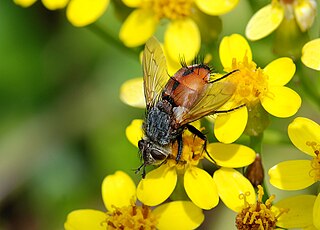
The Brachycera are a suborder of the order Diptera. It is a major suborder consisting of around 120 families. Their most distinguishing characteristic is reduced antenna segmentation.

Hippoboscidae, the louse flies or keds, are obligate parasites of mammals and birds. In this family, the winged species can fly at least reasonably well, though others with vestigial or no wings are flightless and highly apomorphic. As usual in their superfamily Hippoboscoidea, most of the larval development takes place within the mother's body, and pupation occurs almost immediately.

Lipoptena cervi, the deer ked or deer fly, is a species of biting fly in the family of louse flies, Hippoboscidae. These flies are commonly encountered in temperate areas of Europe, Siberia, and northern China. They have been introduced to North America. They are parasites of elk, deer, and other deer family members, burrowing through the fur and sucking the blood of the host animals. Adults are only 5–7 mm (0.20–0.28 in) in length and brownish in colour. Their bodies are flat and elastic, making their removal difficult. L. cervi is a poor flier and can only fly for short distances. Once the insect reaches its target, it sheds its wings and starts burrowing through the fur.

Lipoptena is a genus of flies in the family Hippoboscidae, known as louse flies or keds

Crataerina is a genus of louse flies in the family Hippoboscidae. All are parasites of birds, feeding on the blood of various species of Apodidae (swifts) and Hirundinidae. The genus is sometimes spelled Craterina.
Hippoboscinae is a subfamily of the fly family Hippoboscidae. All are parasitic, and unlike some other members of the Hippoboscidae, all Hippoboscinae are winged species.

Lipopteninae is a subfamily of the fly family Hippoboscidae. All are parasitic.
Lipoptena mazamae, the Neotropical deer ked, is a fly from the family Hippoboscidae. They are blood-feeding parasites of the white-tailed deer - Odocoileus virginianus in the southeastern United States and Central America, the red brocket deer - Mazama americana in Mexico to northern Argentina, and also an incidental parasite of domestic cattle, Cougars - Puma concolor, and man.

Lipoptena depressa, or the Western American deer ked, is species of fly in the family Hippoboscidae. The flies are blood-feeding ectoparasites of mule deer, Odocoileus hemionus and white-tailed deer, Odocoileus virginianus. They are found in the western United States and Canada.
Neolipoptena ferrisi, or the Pacific deer ked, is a species of fly from the family Hippoboscidae. They are blood-feeding parasites of the mule deer - Odocoileus hemionus, the white-tailed deer - Odocoileus virginianus & The Pronghorn - Antilocapra americana. They are found from British Columbia, Canada, to Baja California, Mexico. and Australia.
Neolipoptena is a genus of flies in the family Hippoboscidae.

Hippobosca is a genus of flies in the family Hippoboscidae, with seven known species. There are numerous synonyms.
Ornithophila are a genus of biting flies in the family of louse flies, Hippoboscidae. There are two known species. Both species are parasites of birds.

Ornithomyinae is a subfamily of the fly family Hippoboscidae. All are blood feeding parasites, for the most part on birds, though some have mammals as hosts.

Hippobosca longipennis, the dog fly, louse fly, or blind fly, is a blood-feeding parasite mostly infesting carnivores. The species name "longipennis" means "long wings". Its bites can be painful and result in skin irritation, it is an intermediate host for the canine and hyaenid filarial parasite Dipetalonema dracunculoides, "and it may also be a biological or mechanical vector for other pathogens".
Campeprosopa is a genus of flies in the family Stratiomyidae.
Lipoptena pteropi is a species of fly in the family Hippoboscidae.
Lipoptena capreoli is a species of fly in the family Hippoboscidae. It is found in India, Pakistan, southern Europe, and western Asia.
Lipoptena grahami is a species of fly in the family Hippoboscidae. It is found in China.
Lipoptena paradoxa is a species of fly in the family Hippoboscidae.







